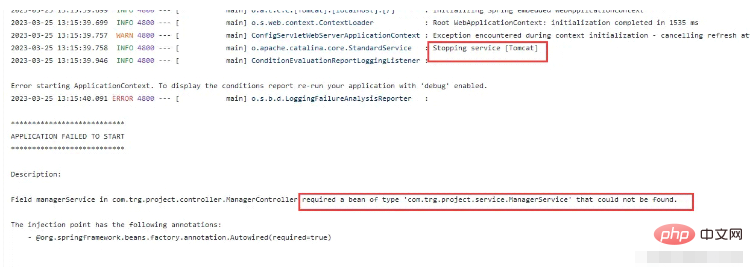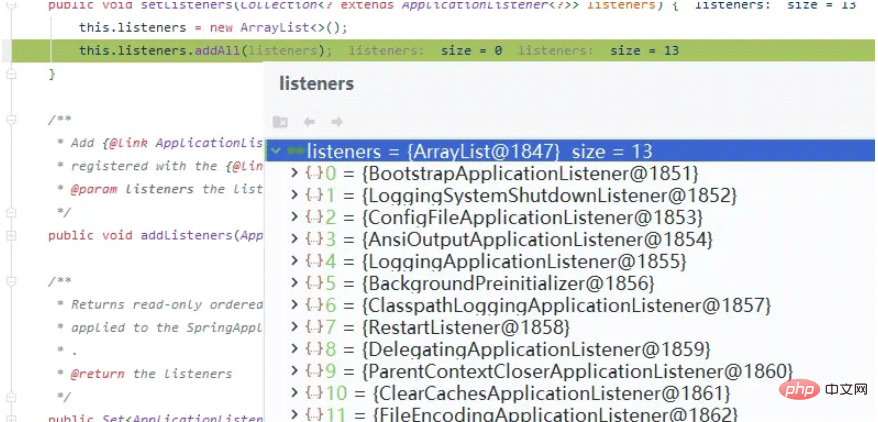Was ist das SpringBoot-Startprinzip?
入口
版本: 2.1.8.RELEASE
启动代码:
@SpringBootApplcation
public static void main(String[] args) {
SpringApplication.run(BlogAdminApplication.class, args);
System.out.println("======== admin start success... ==========");
}这里传入了两个参数,BlogAdminApplication当前类和args参数
我们点击进入run方法查看
public static ConfigurableApplicationContext run(Class<?> primarySource, String... args) {
return run(new Class[]{primarySource}, args);
}这里是将我们写的启动类传入到了Class[]数组中,这步就是个单纯的参数转换。
探讨primarySource参数
那么问题是primarySource能接受的类型是啥样的,是不是什么类都可以接受,带着这个疑问,我们做一个测试,把这个参数给换成一个别的类呢,ManagerController类是一个我写的接口类
@SpringBootApplication
public class BlogProjectApplication {
public static void main(String[] args) {
SpringApplication.run(ManagerController.class, args);
System.out.println("======== admin start success... ==========");
}
}控制台打印
org.springframework.context.ApplicationContextException: Unable to start web server; nested exception is org.springframework.context.ApplicationContextException: Unable to start ServletWebServerApplicationContext due to missing ServletWebServerFactory bean.
提示不能启动服务,提示缺少了ServletWebServerFactory bean 点进这个类看下
@FunctionalInterface
public interface ServletWebServerFactory {
WebServer getWebServer(ServletContextInitializer... initializers);
}他被FunctionalInterface标注了,是一个函数式接口,只有一个getWebServer方法,用来获取webServer的 看下他的实现类,

这不就是提示我们缺少启动的服务容器么,说的直白点,我的理解就是他缺少可以运行的容器,我们知道,没有使用springboot项目之前,我们的项目都是跑在tomcat容器上的,当然也有使用Jetty容器的。再者,我们知道SpringBoot是对tomcat进行了内置。而SpringBoot不仅仅是只有内置了tomcat,而且还内置了好多的东西,比如我们经常使用的mq、redis等等一系列的东西,这个我们可以在spring.factories配置文件中看到,这个文件位于如下位置

大概内容有下,篇幅有限,就不一一列举了。
省略。。。 org.springframework.boot.autoconfigure.EnableAutoConfiguration=\ org.springframework.boot.autoconfigure.admin.SpringApplicationAdminJmxAutoConfiguration,\ org.springframework.boot.autoconfigure.aop.AopAutoConfiguration,\ org.springframework.boot.autoconfigure.amqp.RabbitAutoConfiguration,\ org.springframework.boot.autoconfigure.batch.BatchAutoConfiguration,\ org.springframework.boot.autoconfigure.cache.CacheAutoConfiguration,\ 省略。。。
那么回过头来,我们再看下这个问题,这些个类是如何被加载进来的,我们知道SpingBoot有个注解是开启自动注解的@EnableAutoConfiguration,他就干这个事情的。他能够激活SpringBoot内建和自定义组件的自动装配特性。
那么,知道了这些,我们把这个之前修改后的类给改造一下,加上注解@EnableAutoConfiguration,看下执行效果。
@RestController
@RequestMapping("project/manager")
@EnableAutoConfiguration
public class ManagerController extends AbstractController {运行如下

从打印信息就能知道,服务器有了,只不过下面报错,提示找不到bean,那这不就简单了么,他是不是就是没有扫描到我们的包么,这里就其实可以在配置扫描包的注解继续测试,我就懒的不测试了,直接去看@SpringBootApplication注解
@Target({ElementType.TYPE})
@Retention(RetentionPolicy.RUNTIME)
@Documented
@Inherited
@SpringBootConfiguration
@EnableAutoConfiguration
//
@ComponentScan(
excludeFilters = {@Filter(
type = FilterType.CUSTOM,
classes = {TypeExcludeFilter.class}
), @Filter(
type = FilterType.CUSTOM,
classes = {AutoConfigurationExcludeFilter.class}
)}
)
public @interface SpringBootApplication {@SpringBootApplication这个注解其实就是一个组合注解,里面包含了
元注解:用来标注他是一个注解的,jdk自带的
@SpringBootConfiguration:集成自@Configuration,表示是一个配置类
@EnableAutoConfiguration:激活SpringBoot内建和自定义组件的自动装配特性
@ComponentScan:扫描注解,添加了排除参数,指定排除了一些类
通过这里的实验,我们可以得出结论:
primarySource参数能接收的类是一个配置类,同时要把符合扫描规则的类装配到spring容器中,并且对SpringBoot内置的一些类进行自动扫描到,而这里的@SpringBootApplication注解就是把这些特性都整合到了一起,作为了一个引导类而已。那么说白了,primarySource他接受的其实就是一个配置类。
关于注解详细知识的话,这里就聊这么多了,后面再详细聊。
args参数
args是Java命令行参数,我们在DOS中执行Java程序的时候使用“java 文件名 args参数”。args这个数组可以接收到这些参数。这个是个基础常识了。
以下我们将继续跟踪源码进行分析
我们继续追run()方法
public static ConfigurableApplicationContext run(Class<?>[] primarySources, String[] args) {
return (new SpringApplication(primarySources)).run(args);
}这个方法干了两个事情:
1、new SpringApplication()来创建对象
2、通过创建后的对象,调用对象里面的run()方法
以下我们将从这两个地方进行分析,本篇就先研究第一个
创建对象
我们先看下他是怎么创建对象的,创建了哪些对象,
public SpringApplication(Class<?>... primarySources) {
this((ResourceLoader)null, primarySources);
}
public SpringApplication(ResourceLoader resourceLoader, Class<?>... primarySources) {
//资源加载器
this.resourceLoader = resourceLoader;
//断言
Assert.notNull(primarySources, "PrimarySources must not be null");
//对primarySources进行存储到LinkedHashSet
this.primarySources = new LinkedHashSet<>(Arrays.asList(primarySources));
//1、推断web应用类别
this.webApplicationType = WebApplicationType.deduceFromClasspath();
//2、加载Spring应用上下文初始化
setInitializers((Collection) getSpringFactoriesInstances(ApplicationContextInitializer.class));
//3、加载Spring应用事件监听器
setListeners((Collection) getSpringFactoriesInstances(ApplicationListener.class));
//4、推断应用引导类
this.mainApplicationClass = deduceMainApplicationClass();
}下面研究下主要流程部分
1、推断web应用类别
推断web应用类型属于SpringBoot应用web类型的初始化过程。而该类型也可在SpringApplication构造后,run方法执行之前,通过setWebApplicationType(WebApplicationType webApplicationType)方法进行调整。
在推断Web应用类型的过程中,由于当前Spring应用上下文尚未准备(可在代码执行顺序中看到),所以实现采用的是检查检查当前ClassLoader下基准Class的存在性判断。
上源码
this.webApplicationType = WebApplicationType.deduceFromClasspath();
private static final String[] SERVLET_INDICATOR_CLASSES = { "javax.servlet.Servlet",
"org.springframework.web.context.ConfigurableWebApplicationContext" };
private static final String WEBMVC_INDICATOR_CLASS = "org.springframework." + "web.servlet.DispatcherServlet";
private static final String WEBFLUX_INDICATOR_CLASS = "org." + "springframework.web.reactive.DispatcherHandler";
private static final String JERSEY_INDICATOR_CLASS = "org.glassfish.jersey.servlet.ServletContainer";
private static final String SERVLET_APPLICATION_CONTEXT_CLASS = "org.springframework.web.context.WebApplicationContext";
private static final String REACTIVE_APPLICATION_CONTEXT_CLASS = "org.springframework.boot.web.reactive.context.ReactiveWebApplicationContext";
static WebApplicationType deduceFromClasspath() {
//当DispatcherHandler存在,且DispatcherServlet、ServletContainer两个不存在时;换言之,SpringBoot仅依赖WebFlux存在时,此时的应用类型为REACTIVE
if (ClassUtils.isPresent(WEBFLUX_INDICATOR_CLASS, null) && !ClassUtils.isPresent(WEBMVC_INDICATOR_CLASS, null)
&& !ClassUtils.isPresent(JERSEY_INDICATOR_CLASS, null)) {
return WebApplicationType.REACTIVE;
}
//当Servlet和ConfigurableWebApplicationContext均不存在时,当前应用为非Web应用,即WebApplicationType.NONE,因为这些API均是Spring Web MVC必须的依赖
for (String className : SERVLET_INDICATOR_CLASSES) {
if (!ClassUtils.isPresent(className, null)) {
return WebApplicationType.NONE;
}
}
//当WebFlux和Spring Web MVC同时存在时,Web应用类型同样是Servlet Web,即WebApplicationType.SERVLET
return WebApplicationType.SERVLET;
}2、加载Spring应用上下文初始化
setInitializers((Collection) getSpringFactoriesInstances(ApplicationContextInitializer.class));
此过程包含两个动作,依次为getSpringFactoriesInstances(ApplicationContextInitializer.class)和setInitializers方法。 先看第一个过程
private <T> Collection<T> getSpringFactoriesInstances(Class<T> type) {
return getSpringFactoriesInstances(type, new Class<?>[] {});
}
private <T> Collection<T> getSpringFactoriesInstances(Class<T> type, Class<?>[] parameterTypes, Object... args) {
//获取类加载器
ClassLoader classLoader = getClassLoader();
// Use names and ensure unique to protect against duplicates
//加载了META-INF/spring.factories资源中配置的ApplicationContextInitializer实现类名单。
Set<String> names = new LinkedHashSet<>(SpringFactoriesLoader.loadFactoryNames(type, classLoader));
//初始化
List<T> instances = createSpringFactoriesInstances(type, parameterTypes, classLoader, args, names);
AnnotationAwareOrderComparator.sort(instances);
return instances;
}此处使用了Spring工厂加载机制方法SpringFactoriesLoader.loadFactoryNames(type, classLoader)。加载了META-INF/spring.factories资源中配置的ApplicationContextInitializer实现类名单。

加载完成后使用createSpringFactoriesInstances方法对其进行初始化。
private <T> List<T> createSpringFactoriesInstances(Class<T> type, Class<?>[] parameterTypes,
ClassLoader classLoader, Object[] args, Set<String> names) {
List<T> instances = new ArrayList<>(names.size());
for (String name : names) {
try {
//从类加载器中获取指定类
Class<?> instanceClass = ClassUtils.forName(name, classLoader);
//判断instanceClass是不是type的子类
Assert.isAssignable(type, instanceClass);
//根据以上获取的类名创建类的实例
Constructor<?> constructor = instanceClass.getDeclaredConstructor(parameterTypes);
//排序
T instance = (T) BeanUtils.instantiateClass(constructor, args);
instances.add(instance);
}
catch (Throwable ex) {
throw new IllegalArgumentException("Cannot instantiate " + type + " : " + name, ex);
}
}
return instances;
}3、加载Spring应用事件监听器
setListeners((Collection) getSpringFactoriesInstances(ApplicationListener.class));
此过程与2、加载上下文初始化基本类似。 只不过初始化的对象类型变成了ApplicationListener.class,setListeners方法也只是赋值而已
public void setListeners(Collection<? extends ApplicationListener<?>> listeners) {
this.listeners = new ArrayList<>();
this.listeners.addAll(listeners);
}
4、推断应用引导类
this.mainApplicationClass = deduceMainApplicationClass();
private Class<?> deduceMainApplicationClass() {
try {
StackTraceElement[] stackTrace = new RuntimeException().getStackTrace();
for (StackTraceElement stackTraceElement : stackTrace) {
if ("main".equals(stackTraceElement.getMethodName())) {
return Class.forName(stackTraceElement.getClassName());
}
}
}
catch (ClassNotFoundException ex) {
// Swallow and continue
}
return null;
}这里使用到了new RuntimeException().getStackTrace()来获取堆栈信息,找到调用执行的main方法,从而确定他的类。
这里有个疑问:他不是传了primarySources数组,里面包含了类名么,怎么还用堆栈的方式去获取,此外,这里的堆栈获取也只能获取一个调用的主main方法,他为啥还要传一个Class数组呢?
具体咋获取的,可以追下源码,一直跟踪他的父类Throwable,找到如下代码
/**
* Fills in the execution stack trace. This method records within this
* {@code Throwable} object information about the current state of
* the stack frames for the current thread.
*
* <p>If the stack trace of this {@code Throwable} {@linkplain
* Throwable#Throwable(String, Throwable, boolean, boolean) is not
* writable}, calling this method has no effect.
*
* @return a reference to this {@code Throwable} instance.
* @see java.lang.Throwable#printStackTrace()
*/
public synchronized Throwable fillInStackTrace() {
if (stackTrace != null ||
backtrace != null /* Out of protocol state */ ) {
fillInStackTrace(0);
stackTrace = UNASSIGNED_STACK;
}
return this;
}
private native Throwable fillInStackTrace(int dummy);这里最后调用了native本地方法,去爬取线程堆栈信息,为运行时栈做一份快照。

通过这个图片,可以看到整个方法的调用链,从下往上看哦
Das obige ist der detaillierte Inhalt vonWas ist das SpringBoot-Startprinzip?. Für weitere Informationen folgen Sie bitte anderen verwandten Artikeln auf der PHP chinesischen Website!

Heiße KI -Werkzeuge

Undresser.AI Undress
KI-gestützte App zum Erstellen realistischer Aktfotos

AI Clothes Remover
Online-KI-Tool zum Entfernen von Kleidung aus Fotos.

Undress AI Tool
Ausziehbilder kostenlos

Clothoff.io
KI-Kleiderentferner

AI Hentai Generator
Erstellen Sie kostenlos Ai Hentai.

Heißer Artikel

Heiße Werkzeuge

Notepad++7.3.1
Einfach zu bedienender und kostenloser Code-Editor

SublimeText3 chinesische Version
Chinesische Version, sehr einfach zu bedienen

Senden Sie Studio 13.0.1
Leistungsstarke integrierte PHP-Entwicklungsumgebung

Dreamweaver CS6
Visuelle Webentwicklungstools

SublimeText3 Mac-Version
Codebearbeitungssoftware auf Gottesniveau (SublimeText3)

Heiße Themen
 1382
1382
 52
52
 Wie Springboot Jasypt integriert, um die Verschlüsselung von Konfigurationsdateien zu implementieren
Jun 01, 2023 am 08:55 AM
Wie Springboot Jasypt integriert, um die Verschlüsselung von Konfigurationsdateien zu implementieren
Jun 01, 2023 am 08:55 AM
Einführung in Jasypt Jasypt ist eine Java-Bibliothek, die es einem Entwickler ermöglicht, seinem Projekt mit minimalem Aufwand grundlegende Verschlüsselungsfunktionen hinzuzufügen und kein tiefes Verständnis der Funktionsweise der Verschlüsselung erfordert. standardbasierte Verschlüsselungstechnologie. Passwörter, Text, Zahlen, Binärdateien verschlüsseln ... Geeignet für die Integration in Spring-basierte Anwendungen, offene API, zur Verwendung mit jedem JCE-Anbieter ... Fügen Sie die folgende Abhängigkeit hinzu: com.github.ulisesbocchiojasypt-spring-boot-starter2 Die Vorteile von Jasypt schützen unsere Systemsicherheit. Selbst wenn der Code durchgesickert ist, kann die Datenquelle garantiert werden.
 Wie SpringBoot Redisson integriert, um eine Verzögerungswarteschlange zu implementieren
May 30, 2023 pm 02:40 PM
Wie SpringBoot Redisson integriert, um eine Verzögerungswarteschlange zu implementieren
May 30, 2023 pm 02:40 PM
Nutzungsszenario 1. Die Bestellung wurde erfolgreich aufgegeben, die Zahlung erfolgte jedoch nicht innerhalb von 30 Minuten. Die Zahlung ist abgelaufen und die Bestellung wurde automatisch storniert. 2. Die Bestellung wurde unterzeichnet und es wurde 7 Tage lang keine Bewertung durchgeführt. Wenn die Bestellung abläuft und nicht ausgewertet wird, wird die Bestellung standardmäßig positiv bewertet. Wenn der Händler die Bestellung innerhalb von 5 Minuten nicht erhält, wird die Bestellung abgebrochen Es wird eine SMS-Erinnerung gesendet ... Für Szenarien mit langen Verzögerungen und geringer Echtzeitleistung können wir die Aufgabenplanung verwenden, um eine regelmäßige Abfrageverarbeitung durchzuführen. Zum Beispiel: xxl-job Heute werden wir auswählen
 So implementieren Sie verteilte Sperren mit Redis in SpringBoot
Jun 03, 2023 am 08:16 AM
So implementieren Sie verteilte Sperren mit Redis in SpringBoot
Jun 03, 2023 am 08:16 AM
1. Redis implementiert das Prinzip der verteilten Sperren und warum verteilte Sperren erforderlich sind. Bevor über verteilte Sperren gesprochen wird, muss erläutert werden, warum verteilte Sperren erforderlich sind. Das Gegenteil von verteilten Sperren sind eigenständige Sperren. Wenn wir Multithread-Programme schreiben, vermeiden wir Datenprobleme, die durch den gleichzeitigen Betrieb einer gemeinsam genutzten Variablen verursacht werden. Normalerweise verwenden wir eine Sperre, um die Richtigkeit der gemeinsam genutzten Variablen sicherzustellen Die gemeinsam genutzten Variablen liegen im gleichen Prozess. Wenn es mehrere Prozesse gibt, die gleichzeitig eine gemeinsam genutzte Ressource betreiben müssen, wie können sie sich dann gegenseitig ausschließen? Heutige Geschäftsanwendungen sind in der Regel Microservice-Architekturen, was auch bedeutet, dass eine Anwendung mehrere Prozesse bereitstellen muss. Wenn mehrere Prozesse dieselbe Datensatzzeile in MySQL ändern müssen, ist eine Verteilung erforderlich, um fehlerhafte Daten zu vermeiden wird zu diesem Zeitpunkt eingeführt. Der Stil ist gesperrt. Punkte erreichen wollen
 So lösen Sie das Problem, dass Springboot nach dem Einlesen in ein JAR-Paket nicht auf die Datei zugreifen kann
Jun 03, 2023 pm 04:38 PM
So lösen Sie das Problem, dass Springboot nach dem Einlesen in ein JAR-Paket nicht auf die Datei zugreifen kann
Jun 03, 2023 pm 04:38 PM
Springboot liest die Datei, kann aber nach dem Packen in ein JAR-Paket nicht auf die neueste Entwicklung zugreifen. Es gibt eine Situation, in der Springboot die Datei nach dem Packen in ein JAR-Paket nicht lesen kann ist ungültig und kann nur über den Stream gelesen werden. Die Datei befindet sich unter resources publicvoidtest(){Listnames=newArrayList();InputStreamReaderread=null;try{ClassPathResourceresource=newClassPathResource("name.txt");Input
 So implementieren Sie Springboot+Mybatis-plus, ohne SQL-Anweisungen zum Hinzufügen mehrerer Tabellen zu verwenden
Jun 02, 2023 am 11:07 AM
So implementieren Sie Springboot+Mybatis-plus, ohne SQL-Anweisungen zum Hinzufügen mehrerer Tabellen zu verwenden
Jun 02, 2023 am 11:07 AM
Wenn Springboot + Mybatis-plus keine SQL-Anweisungen zum Hinzufügen mehrerer Tabellen verwendet, werden die Probleme, auf die ich gestoßen bin, durch die Simulation des Denkens in der Testumgebung zerlegt: Erstellen Sie ein BrandDTO-Objekt mit Parametern, um die Übergabe von Parametern an den Hintergrund zu simulieren dass es äußerst schwierig ist, Multi-Table-Operationen in Mybatis-plus durchzuführen. Wenn Sie keine Tools wie Mybatis-plus-join verwenden, können Sie nur die entsprechende Mapper.xml-Datei konfigurieren und die stinkende und lange ResultMap konfigurieren Schreiben Sie die entsprechende SQL-Anweisung. Obwohl diese Methode umständlich erscheint, ist sie äußerst flexibel und ermöglicht es uns
 Vergleich und Differenzanalyse zwischen SpringBoot und SpringMVC
Dec 29, 2023 am 11:02 AM
Vergleich und Differenzanalyse zwischen SpringBoot und SpringMVC
Dec 29, 2023 am 11:02 AM
SpringBoot und SpringMVC sind beide häufig verwendete Frameworks in der Java-Entwicklung, es gibt jedoch einige offensichtliche Unterschiede zwischen ihnen. In diesem Artikel werden die Funktionen und Verwendungsmöglichkeiten dieser beiden Frameworks untersucht und ihre Unterschiede verglichen. Lassen Sie uns zunächst etwas über SpringBoot lernen. SpringBoot wurde vom Pivotal-Team entwickelt, um die Erstellung und Bereitstellung von Anwendungen auf Basis des Spring-Frameworks zu vereinfachen. Es bietet eine schnelle und einfache Möglichkeit, eigenständige, ausführbare Dateien zu erstellen
 Wie SpringBoot Redis anpasst, um die Cache-Serialisierung zu implementieren
Jun 03, 2023 am 11:32 AM
Wie SpringBoot Redis anpasst, um die Cache-Serialisierung zu implementieren
Jun 03, 2023 am 11:32 AM
1. Passen Sie den RedisTemplate1.1-Standard-Serialisierungsmechanismus an. Die API-basierte Redis-Cache-Implementierung verwendet die RedisTemplate-Vorlage für Daten-Caching-Vorgänge. Öffnen Sie hier die RedisTemplate-Klasse und zeigen Sie die Quellcodeinformationen der Klasse publicclassRedisTemplateextendsRedisAccessorimplementsRedisOperations an. Schlüssel deklarieren, verschiedene Serialisierungsmethoden des Werts, der Anfangswert ist leer @NullableprivateRedisSe
 So erhalten Sie den Wert in application.yml in Springboot
Jun 03, 2023 pm 06:43 PM
So erhalten Sie den Wert in application.yml in Springboot
Jun 03, 2023 pm 06:43 PM
In Projekten werden häufig einige Konfigurationsinformationen benötigt. Diese Informationen können in der Testumgebung und in der Produktionsumgebung unterschiedliche Konfigurationen haben und müssen möglicherweise später basierend auf den tatsächlichen Geschäftsbedingungen geändert werden. Wir können diese Konfigurationen nicht fest im Code codieren. Am besten schreiben Sie sie in die Konfigurationsdatei. Sie können diese Informationen beispielsweise in die Datei application.yml schreiben. Wie erhält oder verwendet man diese Adresse im Code? Es gibt 2 Methoden. Methode 1: Wir können den Wert, der dem Schlüssel in der Konfigurationsdatei (application.yml) entspricht, über den mit @Value versehenen Wert erhalten. Diese Methode eignet sich für Situationen, in denen es relativ wenige Mikrodienste gibt: Tatsächlich Projekte, wenn das Geschäft kompliziert ist, Logik




